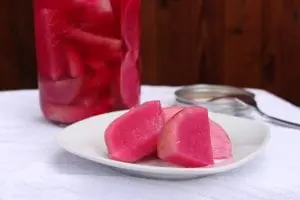1 part chaos, 2 parts calm
By Mary Ann Ebner
When savoring good company — with friends, family or even pets — we all benefit. The same goes for favorable food match-ups, from eggs with bacon to soup and salad. Even though a fine panini capably stands alone, a marriage comes together when a sandwich joins a side dish. Burgers with golden fries may not make the wisest nutritional coupling, but there’s a little love trying to breathe through all that cholesterol.
When a serving of noodles looks deserted on a plate or halibut needs a partnership, consider winter’s survival foods: an array of root crops. As plate companions, they turn a solo helping into a harmonious meal. Mashed, baked, roasted or even pickled, these seasonal staples keep us going when temperatures dip. With December’s first measurable snowfall recorded, winter offers a generous choice of main course and side vegetables.

Along with a host of other farmers at the Cold Spring Farmers’ Market, Cheryl Rogowski of Rogowski Farm grows a range of crops to carry the community through springtime’s arrival. Since 1955, her family has grown heirloom vegetables in Pine Island in the black-dirt region of Orange County. The area consists of thousands of acres of fertile organic soil, turning out cool weather vegetables like sweet potatoes, turnips, carrots and parsnips.
As Rogowski arranged baskets of vegetables flecked with that rich black dirt, she helped a shopper select a pound of bright orange carrots. Like many of her customers, she relies on root vegetables for family meals in cold weather. “I love roasting root vegetables,” she said.
And what this farmer serves at home, she offers at the market. “We’ll have carrots all winter long,” she said. “We’ll also have turnips through winter and we’ll have parsnips probably through February.”

Carrots stay in play throughout the year, but other root crops like rutabagas and turnips are sometimes overlooked during their peak season.
As for parsnips, they add a dash of spice. “I call them the elegant carrot,” Rogowski said. “They also make an insane parsnip cake, and I just substitute them for carrots.”
Parsnips, which resemble carrots in shape, have tan-colored skin and creamy flesh. They boast a woody texture and taste spicy while producing a honeyed aroma when roasted.
When selecting parsnips, look for firm choices with no cracks or blemishes. Rogowski recommends roasting them as you would prepare baby potatoes (425 degrees for 30 to 40 minutes), tossed with a generous amount of oil and seasoned.
“I let the vegetables do the work,” she said. “With potatoes, I’ll add some rosemary, but with the others, they just need a bit of olive oil and sea salt and I finish them with fresh parsley. Come January and February, you need that burst of green.”

Root crops call for little else save a toss or two during roasting. If properly scrubbed, carrots and parsnips don’t necessarily need peeling, though peeling away a thin outer layer encourages a crisper charred finish.
Turnips roast nicely but also serve as constant companions as a ubiquitous pickled side on Middle Eastern menus. I can’t bring turnips home without pickling a few to produce lifit. While my husband lived in Syria during his doctoral studies in 2010, he ate lifit nearly every day alongside a serving of stewed beans. Around our home, the bold pink slices serve as a faithful companion to beans, rice or grilled lamb but lately as a reminder of life itself and the fragile world in which we live.
As 2016 nears its end, may you enjoy roasted, mashed or pickled root vegetables and share a plate with those you cherish most.
Quick Lifit (Pickled Turnips)
1½ to 2 pounds turnips (peeled and sliced)
1 small beet
1 mild pepper pod
1 teaspoon salt
½ cup water
½ cup red wine vinegar
½ cup white vinegar
Boil beet in small saucepan of water until tender. Cool, peel and quarter. Mix water and vinegar and set aside. Place turnips in sterilized quart jar. Add beets, pepper pod and teaspoon of salt. Pour vinegar mixture into jar to completely cover vegetables. Seal jar, label with date and refrigerate seven days, agitating jar for a minute every other day. Lifit will turn bright fuchsia, thanks to the beet.

